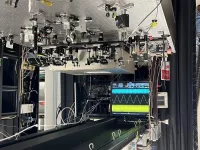(Press-News.org) WASHINGTON — Researchers have developed a new ultrafast laser platform that generates ultra-broadband ultraviolet (UV) frequency combs with an unprecedented one million comb lines, providing exceptional spectral resolution. The new approach, which also produces extremely accurate and stable frequencies, could enhance high-resolution atomic and molecular spectroscopy.
Optical frequency combs — which emit thousands of regularly spaced spectral lines — have transformed fields like metrology, spectroscopy and precision timekeeping via optical atomic clocks, earning the 2005 Nobel Prize in Physics.
The initial frequency combs operated within the visible to near-infrared range. Shortly after their introduction, their spectral range was extended to the UV region through optical harmonic generation, unlocking a new spectral domain for precision laser spectroscopy. “Nevertheless, achieving both broadband coverage and high spectral resolution in the UV range has remained a considerable challenge,” said research team leader Konstantin Vodopyanov from CREOL, The College of Optics & Photonics, at the University of Central Florida.
In Optica, Optica Publishing Group’s journal for high-impact research, the researchers describe their high-resolution dual-comb spectroscopy system, which generates light across two ultra-broad UV spectral regions. With a line spacing of just 80 MHz, the frequency combs exhibit a resolving power of up to 10 million.
“Broadband, high-resolution UV spectroscopy provides unique insights into electronic transitions in atoms and molecules, making it invaluable for applications such as chemical analysis, photochemistry, atmospheric trace gas sensing and exoplanet exploration, where the simultaneous detection of numerous absorption features is essential,” said Vodopyanov.
Dual-comb spectroscopy
To utilize UV frequency combs containing a million closely spaced spectral lines for spectroscopy applications, the researchers needed a method capable of achieving high spectral resolution — beyond the capabilities of existing spectrometers. They turned to dual-comb spectroscopy, a powerful new technique that combines two frequency combs with slightly different line spacings on a single detector, producing interferograms. By applying a Fourier transform, the entire spectrum can be reconstructed with exceptionally high spectral resolution and rapid data acquisition.
"Although, over the past decade, dual-comb spectroscopy has made significant progress in the mid-infrared and terahertz regions, a notable gap remains in the UV spectral range, where existing demonstrations fall short in terms of resolution, bandwidth or both," said Vodopyanov.
To address this challenge, the researchers developed a laser platform that generates highly coherent ultrafast infrared pulses at a wavelength of 2.4 µm. Using a nonlinear crystal, they produced the 6th and 7th harmonics, resulting in two UV bands: the 6th harmonic covering approximately 1,000,000 spectrally resolved comb lines and the 7th harmonic containing around 550,000. This yielded two UV spectral ranges spanning 372–410 nm and 325–342 nm. To enable dual-comb spectroscopy, they replicated the broadband UV frequency comb system, allowing for further refinement of the UV comb's structure
Precision spectral lines
By referencing the spectral lines to an atomic clock, the researchers ensured that they could perform highly precise spectroscopic measurements, suitable for the most demanding applications.
As a demonstration, they used the dual-comb spectroscopy system to measure the narrow reflection spectrum of a volume Bragg grating mirror made by IPG/OptiGrate. The new system achieved a resolving power of 10,000,000, which the researchers say is far superior to existing grating and Fourier spectrometers.
Next, the researchers aim to extend the technology to even deeper UV regions, potentially down to a wavelength of 100 nm.
Paper: A. Muraviev, D. Konnov, S. Vasilyev, K. L. Vodopyanov, “Dual frequency comb UV spectroscopy with one million resolved comb lines,” Optica, 11, 1486-1489 (2024).
DOI: 10.1364/OPTICA.536971.
About Optica
Optica is an open-access journal dedicated to the rapid dissemination of high-impact peer-reviewed research across the entire spectrum of optics and photonics. Published monthly by Optica Publishing Group, the Journal provides a forum for pioneering research to be swiftly accessed by the international community, whether that research is theoretical or experimental, fundamental or applied. Optica maintains a distinguished editorial board of more than 60 associate editors from around the world and is overseen by Editor-in-Chief Prem Kumar, Northwestern University, USA. For more information, visit Optica.
About Optica Publishing Group (formerly OSA)
Optica Publishing Group is a division of Optica, the society advancing optics and photonics worldwide. It publishes the largest collection of peer-reviewed content in optics and photonics, including 18 prestigious journals, the society’s flagship member magazine, and papers from more than 835 conferences, including 6,500+ associated videos. With over 400,000 journal articles, conference papers and videos to search, discover and access, Optica Publishing Group represents the full range of research in the field from around the globe.
Media Contacts:
Aaron Cohen
(301) 633-6773
aaroncohenpr@gmail.com
mediarelations@optica.org
END
Researchers take broadband high-resolution frequency combs into the UV
With unprecedented spectral resolution, new broadband UV frequency combs pave the way to enhanced spectroscopy measurements
2024-10-31
ELSE PRESS RELEASES FROM THIS DATE:
Not going out is the “new normal” post-Covid, say experts
2024-10-31
Compared with just before the Covid-19 pandemic, people are spending nearly an hour less a day doing activities outside the home, behaviour that researchers say is a lasting consequence of the pandemic.
A new study published in the peer-reviewed Journal of the American Planning Association reveals an overall drop since 2019 of about 51 minutes in the daily time spent on out-of-home activities, plus an almost 12-minute reduction in time spent on daily travel such as driving or taking public transportation.
The analysis, based on a survey of 34,000 Americans, ...
Study shows broader screening methods help prevent spread of dangerous fungal pathogen in hospitals
2024-10-31
Study Shows Broader Screening Methods Help Prevent Spread of Dangerous Fungal Pathogen in Hospitals
Screening high-risk patients for Candida auris allows for early detection and implementation of infection control measures to prevent hospital outbreaks
Arlington, Va. — October 31, 2024 — A new study published today in the American Journal of Infection Control (AJIC) describes the outcome of a shift in hospital screening protocols for Candida auris, a dangerous and often drug-resistant fungal pathogen that spreads easily in hospital environments. A comparison of screening results and patient outcomes before ...
Research spotlight: Testing a model for depression care in Malawi using existing medical infrastructure
2024-10-31
How would you summarize your study for a lay audience?
We tested a model of depression care in Malawi, a low-income country in sub-Saharan Africa, that builds off the infrastructure of the country’s HIV delivery system. The intervention involved clinical officers who delivered medications for depression, and it involved lay personnel, people living in the community, to deliver psychotherapy. Unlike past research, we did not limit our evaluation to improvements in depression; we also looked at improvements in other chronic health conditions that participants had, and we measured effects on household members.
What knowledge gap does your study help to ...
Depression care in low-income nations can improve overall health
2024-10-31
Treating people in low-income countries for major depressive disorder can also help improve their physical health and household members’ wellbeing, demonstrating that mental health treatments can be cost effective, according to a new RAND study.
Researchers examined a program in the sub-Saharan nation of Malawi that builds off the infrastructure of the country’s HIV care system and trains local people in rural communities to help treat people who suffer from depression.
The study found participants had significant improvements in their depression symptoms, ...
The BMJ investigates dispute over US group’s involvement in WHO’s trans health guideline
2024-10-30
The World Health Organization (WHO) says that it is adhering to standard protocol in pursuing its transgender health guideline, but the process has been criticised for lacking transparency and an association with WPATH - an organisation that supports the “gender affirming” approach, including hormones and surgery, for all ages - and is under fire for meddling with its own guideline development.
In The BMJ today, freelance journalist Jennifer Block investigates these concerns and the questions they raise about how evidence based the panel’s recommendations would be.
Earlier ...
Personal info and privacy control may be key to better visits with AI doctors
2024-10-30
UNIVERSITY PARK, Pa. — Artificial intelligence (AI) may one day play a larger role in medicine than the online symptom checkers available today. But these “AI doctors” may need to get more personal than human doctors to increase patient satisfaction, according to a study led by researchers at Penn State. They found that the more social information an AI doctor recalls about patients, the higher the patients’ satisfaction, but only if they were offered privacy control.
The research team published their findings in the journal Communication Research.
“We tend to think of AI doctors as machines ...
NIH study demonstrates long-term benefits of weight-loss surgery in young people
2024-10-30
What: Young people with severe obesity who underwent weight-loss surgery at age 19 or younger continued to see sustained weight loss and resolution of common obesity-related comorbidities 10 years later, according to results from a large clinical study funded by the National Institutes of Health (NIH).
Study participants with an average age of 17 underwent gastric bypass or sleeve gastrectomy weight-loss surgery. After 10 years, participants sustained an average of 20% reduction in body mass index (BMI), 55% reduction of type 2 diabetes, 57% reduction of hypertension, and 54% reduction of abnormal cholesterol. Both gastric ...
Sustained remission of diabetes and other obesity-related conditions found a decade after weight loss surgery in adolescence
2024-10-30
Ten years after undergoing bariatric surgery as teens, over half of study participants demonstrated not only sustained weight loss, but also resolution of obesity-related conditions, such as type 2 diabetes, high blood pressure and high cholesterol, according to the report published in the New England Journal of Medicine.
“Our study presents impressive outcomes of the longest follow-up of weight loss surgery during adolescence, which validates bariatric surgery as a safe and effective long-term obesity management strategy,” said lead author Justin Ryder, PhD, Vice Chair of Research for the Department ...
Low-level lead poisoning is still pervasive in the US and globally
2024-10-30
Chronic, low-level lead poisoning is a major risk factor for cardiovascular disease in adults and cognitive deficits in children, even at levels previously thought to be safe, according to a new paper by Columbia University Mailman School of Public Health, Simon Fraser University in Canada, and Harvard Medical School, and Boston Children’s Hospital. Low-level lead poisoning is a risk factor for preterm Birth, cognitive deficits and attention deficit–hyperactivity disorder, (ADHD), as well as increased blood pressure and reduced heart rate variability. The findings ...
How researchers can maximize biological insights using animal-tracking devices
2024-10-30
Biologgers allow us to see with unprecedented precision how animals move and behave in the wild. But that's only part of the picture, according to a UC Santa Cruz ecologist renowned for using biologging data to tell the deeper story about the lives of marine mammals in a changing world.
In a new opinion piece published on October 30 in Trends in Ecology and Evolution, researchers present a framework intended to underscore the value of biologging data for testing important questions about the natural world. They urge that now is the time to build upon "discovery-based science," where observations are presented ...
LAST 30 PRESS RELEASES:
Why nail-biting, procrastination and other self-sabotaging behaviors are rooted in survival instincts
Regional variations in mechanical properties of porcine leptomeninges
Artificial empathy in therapy and healthcare: advancements in interpersonal interaction technologies
Why some brains switch gears more efficiently than others
UVA’s Jundong Li wins ICDM’S 2025 Tao Li Award for data mining, machine learning
UVA’s low-power, high-performance computer power player Mircea Stan earns National Academy of Inventors fellowship
Not playing by the rules: USU researcher explores filamentous algae dynamics in rivers
Do our body clocks influence our risk of dementia?
Anthropologists offer new evidence of bipedalism in long-debated fossil discovery
Safer receipt paper from wood
Dosage-sensitive genes suggest no whole-genome duplications in ancestral angiosperm
First ancient human herpesvirus genomes document their deep history with humans
Why Some Bacteria Survive Antibiotics and How to Stop Them - New study reveals that bacteria can survive antibiotic treatment through two fundamentally different “shutdown modes”
UCLA study links scar healing to dangerous placenta condition
CHANGE-seq-BE finds off-target changes in the genome from base editors
The Journal of Nuclear Medicine Ahead-of-Print Tip Sheet: January 2, 2026
Delayed or absent first dose of measles, mumps, and rubella vaccination
Trends in US preterm birth rates by household income and race and ethnicity
Study identifies potential biomarker linked to progression and brain inflammation in multiple sclerosis
Many mothers in Norway do not show up for postnatal check-ups
Researchers want to find out why quick clay is so unstable
Superradiant spins show teamwork at the quantum scale
Cleveland Clinic Research links tumor bacteria to immunotherapy resistance in head and neck cancer
First Editorial of 2026: Resisting AI slop
Joint ground- and space-based observations reveal Saturn-mass rogue planet
Inheritable genetic variant offers protection against blood cancer risk and progression
Pigs settled Pacific islands alongside early human voyagers
A Coral reef’s daily pulse reshapes microbes in surrounding waters
EAST Tokamak experiments exceed plasma density limit, offering new approach to fusion ignition
Groundbreaking discovery reveals Africa’s oldest cremation pyre and complex ritual practices
[Press-News.org] Researchers take broadband high-resolution frequency combs into the UVWith unprecedented spectral resolution, new broadband UV frequency combs pave the way to enhanced spectroscopy measurements


